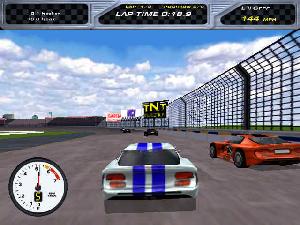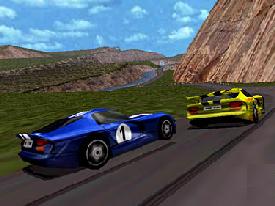“HornBall! BodyWork! A Red Biplane?”
Well, lookie here campers. If we don’t just have another racin’ tech-demo!
Yessire! As uh matter ‘o fact, in this one yuh can bust up yur fender and shatter
all dem winduhs. Yup boss, we got ourselves uh com-plete damage mod-eling system
rights about here! HICK!
How do most racing games make names for themselves? Good control? Kick ass
graphics? Axle breaking chases with the long arm of the road-kill law? Illegal
weapons? Pedestrian splattering? Well, one thing that you can be assured is
that most do not promote themselves based on a hyper realistic 3D visual/physical
damage modeling system. Viper Racing, on the other hand, does.
Viper Racing is the first racing
simulation that exclusively models the Dodge Viper GTS-R (Racing Edition). Now,
a lot of realistic racing games out there have you driving Indy Cars, Nascars,
or Formula 1 cars. Viper Racing, in direct contrast, is the first simulation
racing game that I can think of that has you driving in style. The Dodge Viper
is one of those cars that are on the road to put the fear of god into the guy
in the lane over on the expressway. It’s a true blue racecar just barely fitted
into the body of one of the world’s most stylish sports cars.
Viper Racing is a good sim, a foxy 3D engine, an entertaining game,
and, thanks to a miracle of a fine print contract blunder on the part of Dodge,
a kick ass demonstration of what drunk driving can do to a perfectly fine fuselage.
Yes, because Dodge never made it clear that MGI, the developers of Viper
Racing (mostly old Papyrus chaps), could not model damage to the Viper .
. . you can trash the sucker beyond the wildest dreams of Smokey and them Duke
boys.
The way that the damage modeling works in Viper Racing is that the
entire car is a polygon mesh which can be dynamically adjusted. So, based on
the physical impact force of a rock or tree, you will either lose an appropriate
amount of the space below your hood, or your bumper will be a foot higher and
your front wheel will be bashed into the engine compartment. Even paint job
scraping is included. In fact, the only thing that Viper Racing does
not do is shatter your windshield, which seems a little strange.
Even included is a “wheelie” button which pops your car into the air whenever it is pressed. If you continually pop wheelies, the actual body of your car will become so compacted that all you can see are your 4 wheels strung together . . . Neat.
By now I assume that your all shouting “What about the gameplay?! Tell us
now Johnny B.! We are lost without you!” (Well, not really. – Ed.)
The game basically gives you 3 ways to drive. Quick Race, Carrier, and Multiplayer.
I shouldn’t have to explain Quick Race or the adequate Multiplayer but Carrier
is fairly interesting. In Carrier, you earn money depending on your finish position
and with this cash you can by some sweet little accessories for your favorite
Viper.
The racing itself is compelling. The game can be played in varying levels
of realism between Arcade and Simulation. Arcade is not
Need For Speed 3 or DethKarz, but it is accessible
enough to the average everyday gamer who is not familiar with the proper procedures
for finessing a Formula 1 racecar into 1st place at Monaco. In simulation, you
basically spin out a lot, but this is not a flaw in the very accurate physics
model of the Viper. The damned thing just has a whacked power distribution between
front and rear.
The tracks are decently designed, ranging from your average IndyCar loop,
to a jaunt around the outside of a metropolis. One very original feature of
the tracks is that there are no actual boundaries; the entire track is a connected
3D surface on which you can drive anywhere. So, if you flick on the “Pave the
World” hack (there are a few hacks included in the game menus including Hornball,
a few new car models, and even a Red Biplane), you could drive off into the
grassy fields for a couple of miles. The tracks feature some nicely laid out
dips and turns so that conventional simulation racing wisdom still applies here,
even though you are on unconventional tracks.

The Graphics. Well, the graphics are decent, but not exceptional. The track
and car modeling is compelling but the textures are fairly plain and the game
has a certain Spartan feel to it as there are no colored lighting effects. However,
the cars feature some very convincing reflections and some very nice window
transparencies that actually allow you to see your driver through the back windshield.
There is also a car paint job editor included if you just gotta stencil your
girlfriend’s name to the side. One thing I did not like about the graphics is
that they did little to invoke a real sense of speed. That is a fairly serious
flaw considering that a Dodge Viper GTS-R can achieve 200+ MPH speeds.
The game includes almost every view available. They range from 3D cockpit, to overhead, to behind car cam, to a view showing the front wheels and shock assembly (shows off the physics model), and others. There are about 10 slick views in all.
So, the problems. Well, sound isn’t a problem; not a boon either, but it ain’t
the problem. The problem is that the game feels like there just isn’t much to
it. I cant quite put my finger on any one thing. Perhaps it was the sterility
of the textures, the lack of a sense of speed, or the fairly bland appearance
of the tracks, but I was easily bored with Viper Racing. It’s one of
those games that feels like a technology demo with no real gameplay.
In the end, serious sim freaks are probably going to like Viper Racing
a great deal. It has just about everything they usually expect to get in their
diet of axle grease, and even gives them a few new environments to get their
fix in. For the rest of us, the main attraction will be the effect of the wheelie
button. But, two questions remain: 1) Why does a cactus have the structural
integrity to compact the front of a Viper in a collision? 2) For god’s sake,
why in the hell does the opening movie use audio quotes from the beginning of
Star Trek 4: The Voyage Home?!











